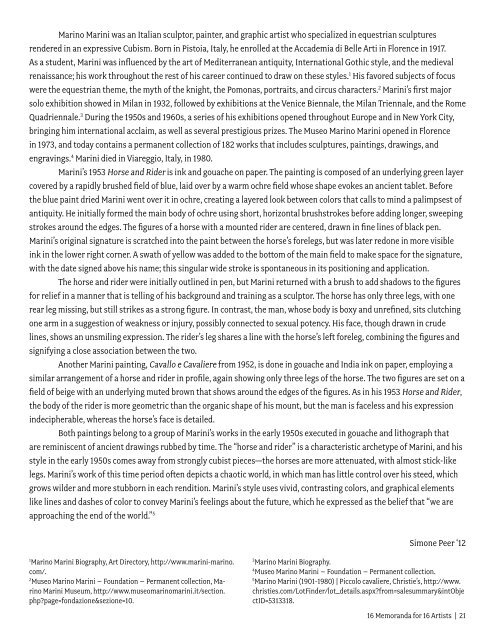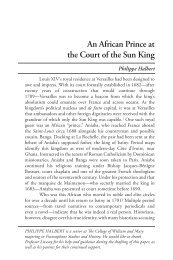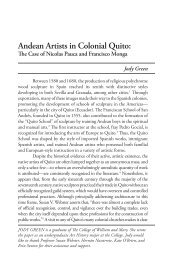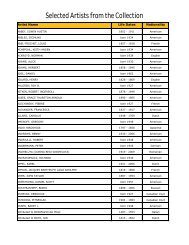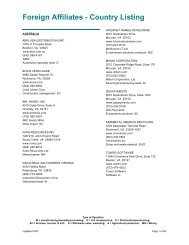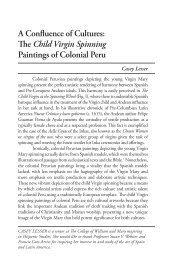Curators at Work - College of William and Mary
Curators at Work - College of William and Mary
Curators at Work - College of William and Mary
You also want an ePaper? Increase the reach of your titles
YUMPU automatically turns print PDFs into web optimized ePapers that Google loves.
Marino Marini was an Italian sculptor, painter, <strong>and</strong> graphic artist who specialized in equestrian sculptures<br />
rendered in an expressive Cubism. Born in Pistoia, Italy, he enrolled <strong>at</strong> the Accademia di Belle Arti in Florence in 1917.<br />
As a student, Marini was influenced by the art <strong>of</strong> Mediterranean antiquity, Intern<strong>at</strong>ional Gothic style, <strong>and</strong> the medieval<br />
renaissance; his work throughout the rest <strong>of</strong> his career continued to draw on these styles. 1 His favored subjects <strong>of</strong> focus<br />
were the equestrian theme, the myth <strong>of</strong> the knight, the Pomonas, portraits, <strong>and</strong> circus characters. 2 Marini’s first major<br />
solo exhibition showed in Milan in 1932, followed by exhibitions <strong>at</strong> the Venice Biennale, the Milan Triennale, <strong>and</strong> the Rome<br />
Quadriennale. 3 During the 1950s <strong>and</strong> 1960s, a series <strong>of</strong> his exhibitions opened throughout Europe <strong>and</strong> in New York City,<br />
bringing him intern<strong>at</strong>ional acclaim, as well as several prestigious prizes. The Museo Marino Marini opened in Florence<br />
in 1973, <strong>and</strong> today contains a permanent collection <strong>of</strong> 182 works th<strong>at</strong> includes sculptures, paintings, drawings, <strong>and</strong><br />
engravings. 4 Marini died in Viareggio, Italy, in 1980.<br />
Marini’s 1953 Horse <strong>and</strong> Rider is ink <strong>and</strong> gouache on paper. The painting is composed <strong>of</strong> an underlying green layer<br />
covered by a rapidly brushed field <strong>of</strong> blue, laid over by a warm ochre field whose shape evokes an ancient tablet. Before<br />
the blue paint dried Marini went over it in ochre, cre<strong>at</strong>ing a layered look between colors th<strong>at</strong> calls to mind a palimpsest <strong>of</strong><br />
antiquity. He initially formed the main body <strong>of</strong> ochre using short, horizontal brushstrokes before adding longer, sweeping<br />
strokes around the edges. The figures <strong>of</strong> a horse with a mounted rider are centered, drawn in fine lines <strong>of</strong> black pen.<br />
Marini’s original sign<strong>at</strong>ure is scr<strong>at</strong>ched into the paint between the horse’s forelegs, but was l<strong>at</strong>er redone in more visible<br />
ink in the lower right corner. A sw<strong>at</strong>h <strong>of</strong> yellow was added to the bottom <strong>of</strong> the main field to make space for the sign<strong>at</strong>ure,<br />
with the d<strong>at</strong>e signed above his name; this singular wide stroke is spontaneous in its positioning <strong>and</strong> applic<strong>at</strong>ion.<br />
The horse <strong>and</strong> rider were initially outlined in pen, but Marini returned with a brush to add shadows to the figures<br />
for relief in a manner th<strong>at</strong> is telling <strong>of</strong> his background <strong>and</strong> training as a sculptor. The horse has only three legs, with one<br />
rear leg missing, but still strikes as a strong figure. In contrast, the man, whose body is boxy <strong>and</strong> unrefined, sits clutching<br />
one arm in a suggestion <strong>of</strong> weakness or injury, possibly connected to sexual potency. His face, though drawn in crude<br />
lines, shows an unsmiling expression. The rider’s leg shares a line with the horse’s left foreleg, combining the figures <strong>and</strong><br />
signifying a close associ<strong>at</strong>ion between the two.<br />
Another Marini painting, Cavallo e Cavaliere from 1952, is done in gouache <strong>and</strong> India ink on paper, employing a<br />
similar arrangement <strong>of</strong> a horse <strong>and</strong> rider in pr<strong>of</strong>ile, again showing only three legs <strong>of</strong> the horse. The two figures are set on a<br />
field <strong>of</strong> beige with an underlying muted brown th<strong>at</strong> shows around the edges <strong>of</strong> the figures. As in his 1953 Horse <strong>and</strong> Rider,<br />
the body <strong>of</strong> the rider is more geometric than the organic shape <strong>of</strong> his mount, but the man is faceless <strong>and</strong> his expression<br />
indecipherable, whereas the horse’s face is detailed.<br />
Both paintings belong to a group <strong>of</strong> Marini’s works in the early 1950s executed in gouache <strong>and</strong> lithograph th<strong>at</strong><br />
are reminiscent <strong>of</strong> ancient drawings rubbed by time. The “horse <strong>and</strong> rider” is a characteristic archetype <strong>of</strong> Marini, <strong>and</strong> his<br />
style in the early 1950s comes away from strongly cubist pieces—the horses are more <strong>at</strong>tenu<strong>at</strong>ed, with almost stick-like<br />
legs. Marini’s work <strong>of</strong> this time period <strong>of</strong>ten depicts a chaotic world, in which man has little control over his steed, which<br />
grows wilder <strong>and</strong> more stubborn in each rendition. Marini’s style uses vivid, contrasting colors, <strong>and</strong> graphical elements<br />
like lines <strong>and</strong> dashes <strong>of</strong> color to convey Marini’s feelings about the future, which he expressed as the belief th<strong>at</strong> “we are<br />
approaching the end <strong>of</strong> the world.” 5<br />
1Marino Marini Biography, Art Directory, http://www.marini-marino.<br />
com/.<br />
2Museo Marino Marini – Found<strong>at</strong>ion – Permanent collection, Marino<br />
Marini Museum, http://www.museomarinomarini.it/section.<br />
php?page=fondazione&sezione=10.<br />
Simone Peer ‘12<br />
3 Marino Marini Biography.<br />
4 Museo Marino Marini – Found<strong>at</strong>ion – Permanent collection.<br />
5 Marino Marini (1901-1980) | Piccolo cavaliere, Christie’s, http://www.<br />
christies.com/LotFinder/lot_details.aspx?from=salesummary&intObje<br />
ctID=5313318.<br />
16 Memor<strong>and</strong>a for 16 Artists | 21


